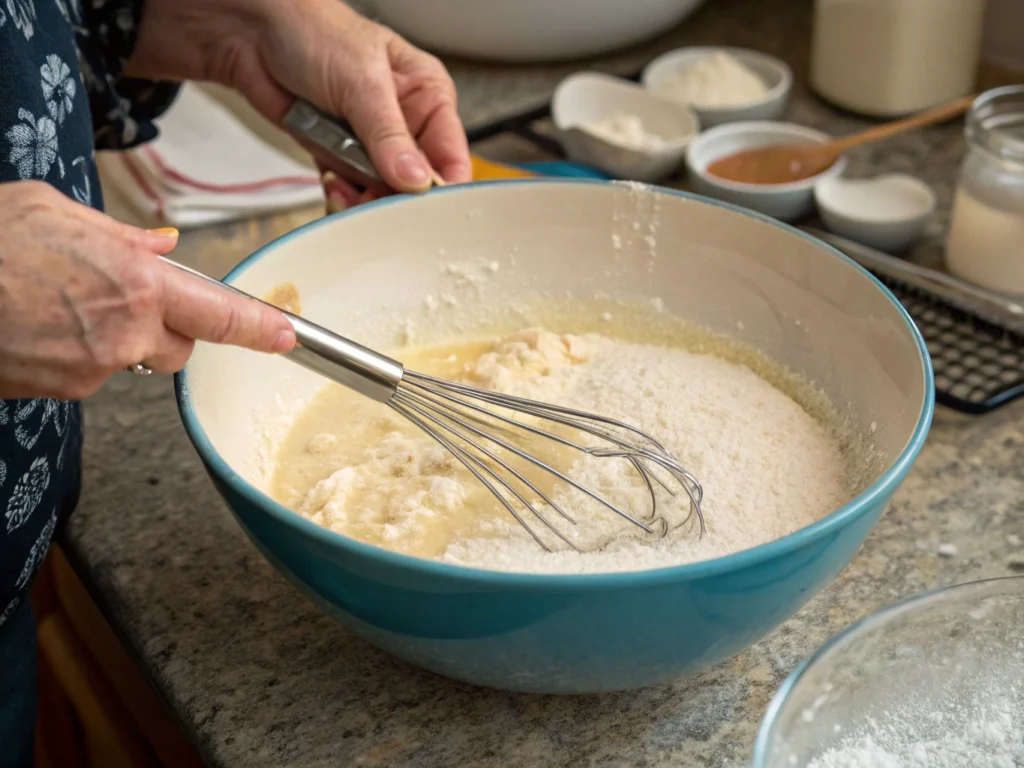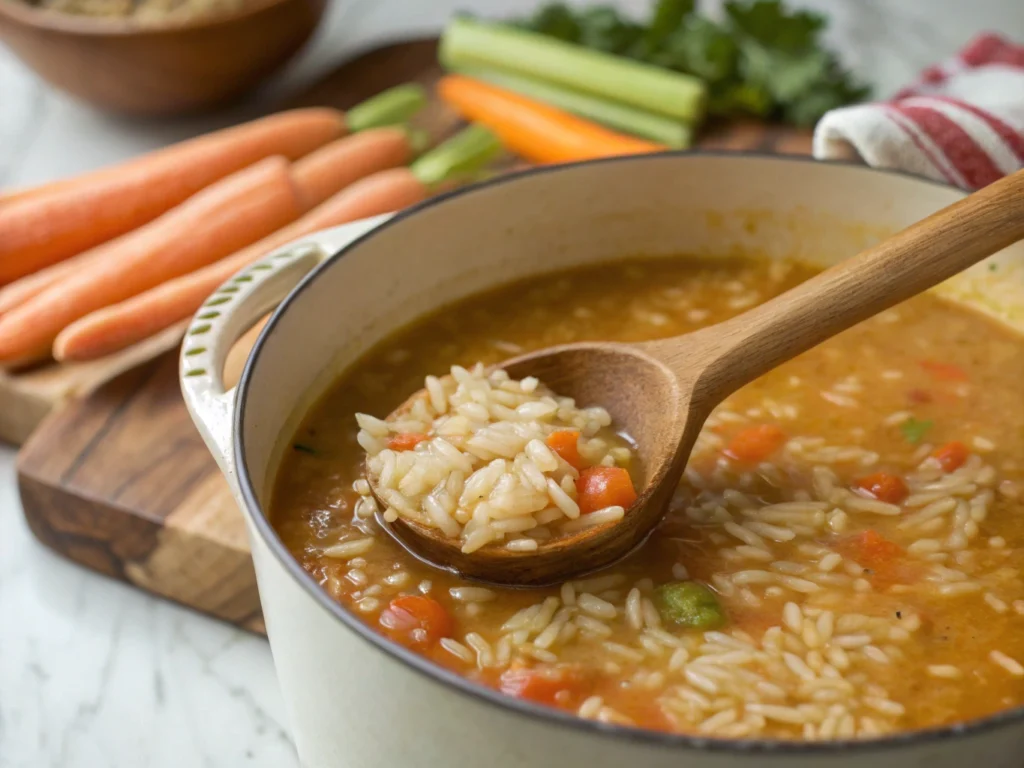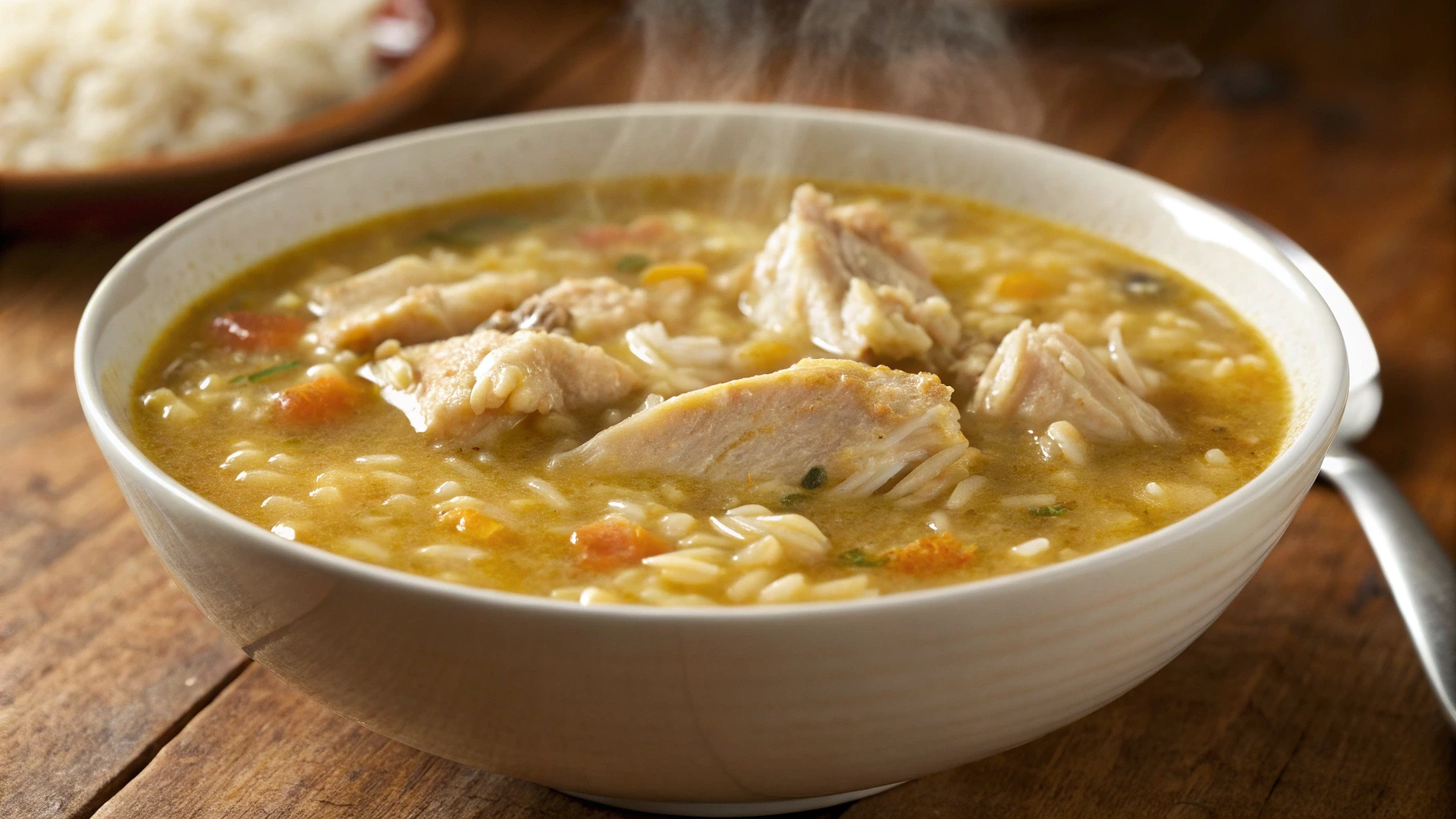Chicken and rice soup is a timeless comfort food, offering warmth, flavor, and nourishment in every spoonful. But what happens when your soup turns out thinner than expected? Don’t worry! This article dives into the best techniques, natural methods, and creative alternatives to thicken up chicken and rice soup. Whether you prefer traditional methods like using flour or modern tricks with starchy ingredients, you’ll find solutions here that not only improve the texture but enhance the flavor too. Get ready to turn your soup into the hearty, satisfying dish it’s meant to be!
Introduction
The Importance of a Perfectly Thickened Soup
A well-thickened chicken and rice soup can transform a simple meal into a luxurious treat. The rich texture adds depth and body, making each bite a cozy hug in a bowl. When the soup is too thin, it can feel more like a broth, leaving you craving something more substantial. That’s why understanding how to control the consistency of your soup is a culinary game-changer.
Overview: Chicken and Rice Soup as a Comfort Food
Chicken and rice soup is celebrated worldwide for its versatility and ease of preparation. It’s a dish that adapts to whatever ingredients you have on hand—vegetables, herbs, or even a splash of cream. Thickening it elevates its appeal, ensuring it’s not just a starter but a meal in itself. From classic recipes to gluten-free tweaks, there’s a thickening method for everyone. And yes, you’ll learn all of them here!
Common Reasons for Thin Chicken and Rice Soup
Why Your Chicken and Rice Soup Might Be Too Thin
One of the most common culprits behind thin chicken and rice soup is too much liquid. It’s easy to overestimate how much broth or water is needed, especially if you’re improvising. Remember, the rice and chicken naturally release juices as they cook, which adds liquid to the soup. If you’ve accidentally poured in too much broth, don’t fret—there are ways to fix it. Adjusting liquid ratios during cooking is an essential step to getting the perfect consistency.
Ineffective Ingredient Ratios
Another issue could be imbalanced ingredient proportions. If there’s not enough rice, vegetables, or thickening agents to match the liquid, the soup will stay watery. Rice, in particular, acts as a natural thickener as it cooks and absorbs liquid. If your recipe doesn’t include enough rice, your soup might lack the heartiness you’re looking for. Keeping the right balance is key when considering how to thicken up chicken and rice soup.
Avoiding Common Mistakes in Thickening Soups
Lastly, soups often thicken naturally as they cool, especially those containing rice or starch-heavy ingredients. If you’re impatient and try thickening the soup too early, you might end up overdoing it. Patience is essential—allowing the soup to rest can reveal its true texture. If it’s still too thin after resting, then it’s time to explore other thickening options.
Traditional Thickening Techniques
Using Flour or Cornstarch to Thicken Chicken and Rice Soup

A classic way to thicken soup is by using flour or cornstarch. These pantry staples are easy to find and simple to use.
How to Make a Slurry:
To create a slurry, mix equal parts flour or cornstarch with cold water. Stir until the mixture is smooth and lump-free. Gradually pour it into your soup while stirring constantly. The heat will activate the thickening properties, giving your soup a silky consistency.
Tips for Preventing Lumps:
Nobody likes a lumpy soup! To avoid clumps, always mix your thickening agent with cold water before adding it to the hot soup. Adding the slurry slowly and stirring vigorously helps distribute it evenly.
Adding a Roux
For a richer flavor, a roux is your best bet. This French-inspired thickener combines flour and fat (typically butter) to create a smooth paste that adds both thickness and depth of flavor.
What is a Roux?
A roux is a cooked mixture of equal parts flour and fat. It’s used as a base in many classic dishes, from stews to sauces.
Step-by-Step Guide to Incorporating a Roux:
- Melt butter in a small pan over medium heat.
- Stir in an equal amount of flour.
- Cook the mixture for a few minutes until it turns golden brown and smells nutty.
- Gradually whisk the roux into your soup, letting it simmer until it reaches your desired thickness.
Traditional methods like these not only answer how to thicken up chicken and rice soup?, but they also elevate the soup’s flavor profile. Whether you prefer a simple slurry or a flavorful roux, these techniques will make your soup irresistibly hearty.
Natural Ways to Thicken Chicken and Rice Soup
How Blending Rice Naturally Thickens Soup

For those who prefer to keep things natural, blending or mashing ingredients is a fantastic option. By pureeing part of the soup, you can create a thicker base without adding extra ingredients.
Blending Rice for a Creamy Base:
Rice is naturally starchy and blends beautifully to create a creamy texture. Scoop out a portion of the soup, blend it until smooth, and then stir it back into the pot. This method enhances the soup’s consistency while keeping the flavors intact.
Mashing Vegetables for Added Thickness:
If your soup contains hearty vegetables like potatoes, carrots, or squash, mash them directly in the pot. This adds bulk and thickness while preserving the natural flavors of the ingredients. Plus, it’s a great way to use up any extra veggies!
Using Potatoes and Vegetables to Thicken Chicken Soup
Starch is a secret weapon for thickening soups naturally and deliciously.
Potatoes as a Natural Thickener:
Adding diced potatoes to your soup can work wonders. As they cook, they release starch, subtly thickening the broth. For an even thicker result, mash the cooked potatoes into the soup.
Cooking Additional Rice for Texture:
Cooking more rice than the recipe calls for is a simple trick for making soup heartier. The extra rice absorbs the liquid, creating a thicker and creamier texture. This approach is a no-fail solution for how to thicken up chicken and rice soup.
For more cozy soup ideas, check out the recipe for Spicy Chicken Soup with Rice.
Enhancing Flavor While Thickening
How Dairy Products Can Thicken and Enrich Chicken Soup
Adding dairy to your soup can achieve two goals: thickening the texture and boosting the flavor.
Cream, Milk, or Yogurt as Thickeners:
Cream and milk are excellent choices for achieving a rich, velvety consistency. If you prefer a tangy twist, opt for plain yogurt. Stir these in during the final stages of cooking to avoid curdling.
Balancing Richness with Other Flavors:
While dairy adds richness, it’s essential to maintain a balance. Brighten the soup with a squeeze of lemon or a sprinkle of fresh herbs to keep the flavors lively.
Incorporating Cheese for Texture and Taste
Cheese lovers, rejoice! Melting cheese into your soup can thicken it while imparting a savory depth of flavor.
Adding Cheese for a Creamy, Flavorful Soup
Cheddar, Parmesan, or even cream cheese work beautifully in chicken and rice soup. Shred or cube the cheese and stir it in gradually until melted. Not only does it thicken the soup, but it also enhances its overall flavor profile.
For more delicious inspiration, don’t miss our recipe for Chicken Fried Rice.
Creative Thickening Alternatives
Egg Yolks: A Gourmet Way to Thicken Chicken Soup
If you’re looking for a gourmet touch, egg yolks are an unexpected but effective way to thicken soup. This method is especially useful if you want to maintain a light yet creamy texture.
How to Temper Eggs to Avoid Curdling:
To use egg yolks as a thickener, start by whisking them in a separate bowl. Slowly add a ladle of hot soup to the yolks, whisking constantly. This process, called tempering, prevents the eggs from scrambling. Once the mixture is smooth, stir it back into the soup. The result? A velvety consistency that’s simply irresistible.
How Pureed Beans Can Add Texture to Chicken and Rice Soup
For a protein-packed alternative, legumes and beans are your best friends. Not only do they thicken the soup, but they also add a nutritional boost.
Protein-Packed Options for a Thicker Soup:
Blend cooked white beans, chickpeas, or lentils and stir the puree into the soup. The creamy texture blends seamlessly, enhancing both thickness and flavor. This trick works wonders for how to thicken up chicken and rice soup without needing flour or starch.
If you enjoy experimenting with flavors, check out this recipe for Chopt Spicy Chicken Soup.
Mistakes to Avoid When Thickening Soup
Over-Thickening Chicken and Rice Soup: What to Avoid
It’s tempting to keep adding thickening agents, but too much can result in a soup that feels more like a paste. Similarly, overcooking ingredients like rice or vegetables can make them lose their integrity, leading to a mushy texture. Always add thickeners gradually and check the consistency as you go.
Tips for Perfect Soup Consistency
Another common mistake is not monitoring the soup’s texture during cooking. Remember, the soup will thicken as it cools, so what seems perfect on the stove might become too thick when served. Stir frequently and adjust liquids as needed to maintain the ideal balance.
These simple tips can save you from common pitfalls and ensure that your soup turns out just right every time. Whether you’re using traditional or creative methods, mastering how to thicken up chicken and rice soup requires attention to detail and a little patience.
Frequently Asked Questions (FAQs)
Can Instant Rice Thicken Chicken Soup Quickly?
Yes, instant rice is a fast and effective way to thicken your soup. Unlike regular rice, it cooks quickly and absorbs liquid rapidly, creating a thicker texture in minutes. Simply stir in a handful of instant rice toward the end of cooking, and let it sit for a few minutes. This method is a game-changer for anyone wondering how to thicken up chicken and rice soup in a pinch.
What’s the Best Gluten-Free Thickener for Chicken Soup?
If you need a gluten-free option, there are plenty of choices! Cornstarch, arrowroot powder, and potato starch are excellent alternatives to flour. These thickeners are easy to use and won’t compromise the soup’s flavor. For a natural approach, try blending some of the rice or vegetables directly in the soup to create a hearty texture without any added ingredients.
How Can I Fix a Soup That is Too Thick?
If your soup turns out too thick, don’t worry—it’s easy to fix. Gradually add more liquid, such as chicken broth or water, while stirring. Taste as you go to ensure the flavors remain balanced. Thin soups can always be thickened again, so start with small amounts of liquid until you achieve the perfect consistency.
Conclusion and Final Tips

Recap of the Best Methods
Learning how to thicken up chicken and rice soup opens up a world of possibilities to customize your dish. From traditional methods like using a roux or cornstarch slurry to natural options like mashed vegetables or blended rice, there’s a technique for every preference. Creative alternatives, such as egg yolks or pureed beans, add unique textures and flavors, making your soup stand out.
Encouragement to Experiment with Ingredients
Every soup recipe is an opportunity to experiment. Don’t be afraid to try new thickening methods or adjust the ingredients to suit your tastes. With a little practice and creativity, you’ll master the art of thickening soups and create dishes that are not only comforting but unforgettable.

